Greenbelt, Maryland, US
Reuters
NASA on Tuesday drew back the curtain on billions of years of cosmic evolution with the inaugural batch of photos from the largest, most powerful observatory ever launched to space, saying the luminous imagery showed the telescope exceeds expectations.
The first full-colour, high-resolution pictures from the James Webb Space Telescope, designed to peer farther than before with greater clarity to the dawn of the universe, were hailed by NASA as milestone marking a new era of astronomical exploration.
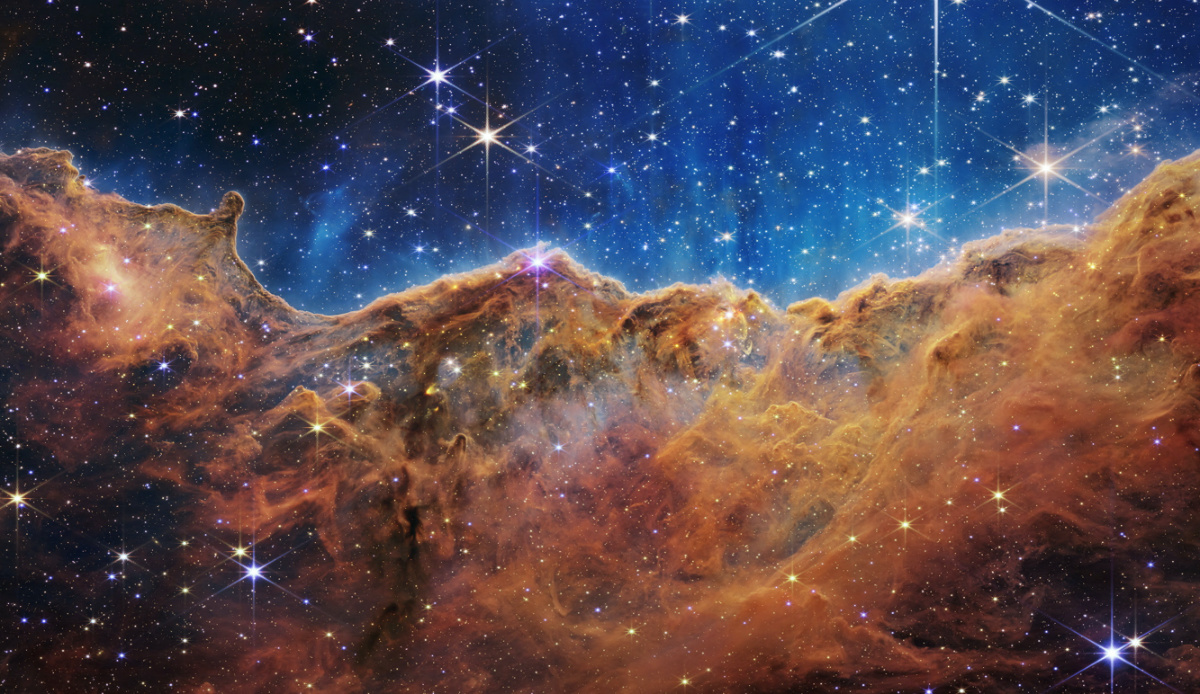
The “Cosmic Cliffs” of the Carina Nebula is seen in an image divided horizontally by an undulating line between a cloudscape forming a nebula along the bottom portion and a comparatively clear upper portion, with data from NASA’s James Webb Space Telescope, a revolutionary apparatus designed to peer through the cosmos to the dawn of the universe and released on 12th July. Speckled across both portions is a starfield, showing innumerable stars of many sizes. PICTURE: NASA, ESA, CSA, STScI, Webb ERO Production Team/Handout via Reuters.
Nearly two decades in the making and built under contract for NASA by aerospace giant Northrop Grumman Corp, the $US9 billion infrared telescope was launched on 25th December, 2021. It reached its destination in solar orbit nearly one million miles from Earth a month later.
With Webb finely tuned after months spent remotely aligning its mirrors and calibrating its instruments, scientists will embark on a competitively selected agenda exploring the evolution of galaxies, life cycle of stars, atmospheres of distant exoplanets, and moons of our outer solar system.
“All of us are just blown away,” Amber Straughn, Webb deputy project scientist at NASA’s Goddard Space Flight Center in Maryland, said among a panel of experts who briefed reporters following the big reveal.
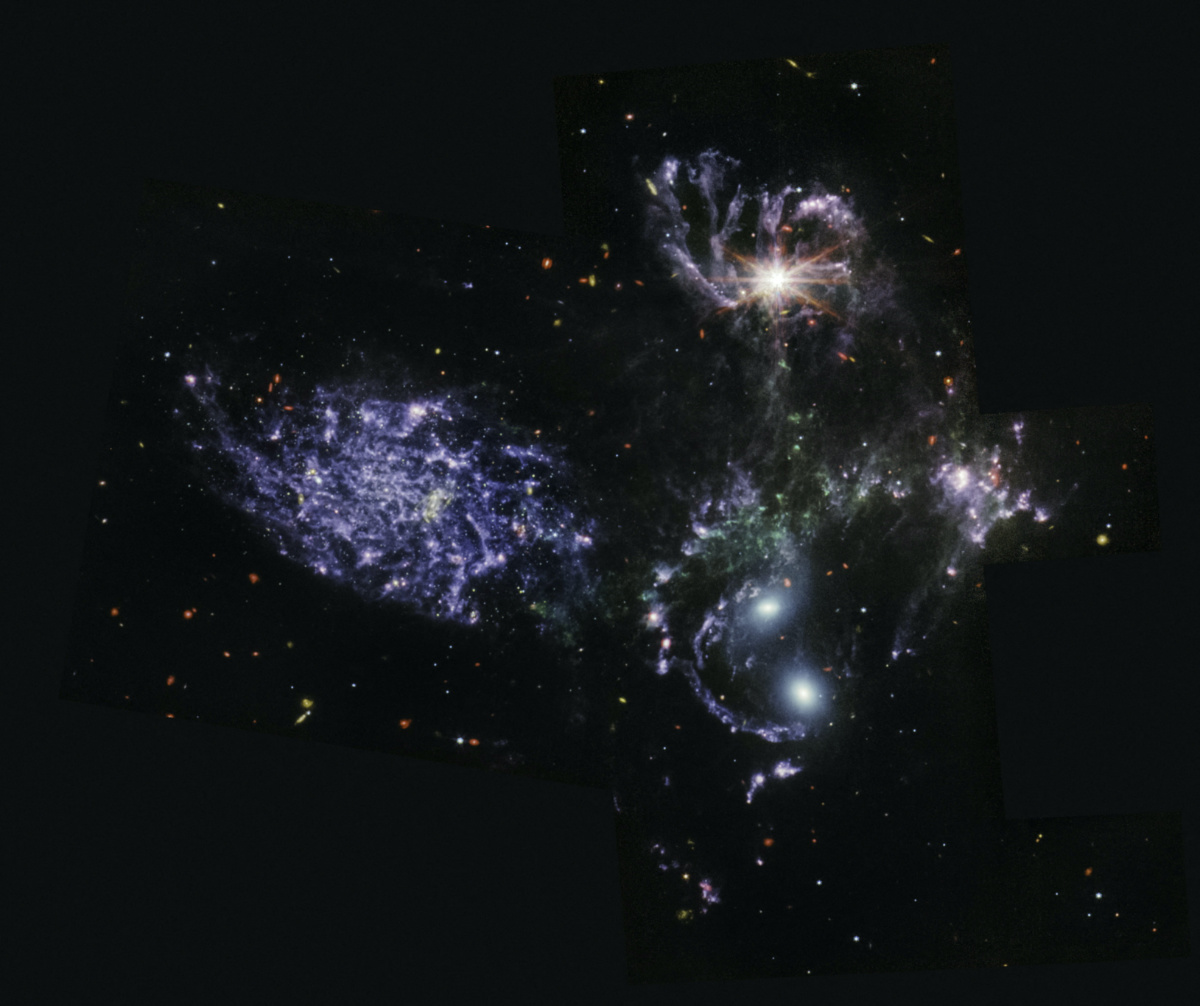
Stephan’s Quintet, a collection of five galaxies, as seen by MIRI from NASA’s James Webb Space Telescope, a revolutionary apparatus designed to peer through the cosmos to the dawn of the universe and released on 12th July. PICTURE: NASA, ESA, CSA, STScI, Webb ERO Production Team/Handout via Reuters.
Whoops and hollers from a sprightly “cheer team” welcomed some 300 scientists, telescope engineers, politicians and senior officials from NASA and its international partners into a packed and auditorium at Goddard for the official unveiling.
“I didn’t know I was coming to a pep rally,” NASA Administrator James Nelson said from the stage, enthusing that Webb’s “every image is a discovery.”
The event was simulcast to watch parties of astronomy enthusiasts worldwide, from Bhopal, India, to Vancouver, British Columbia.
The first photos, which took weeks to render from raw telescope data, were selected by NASA to show off Webb’s capabilities and foreshadow science missions ahead.
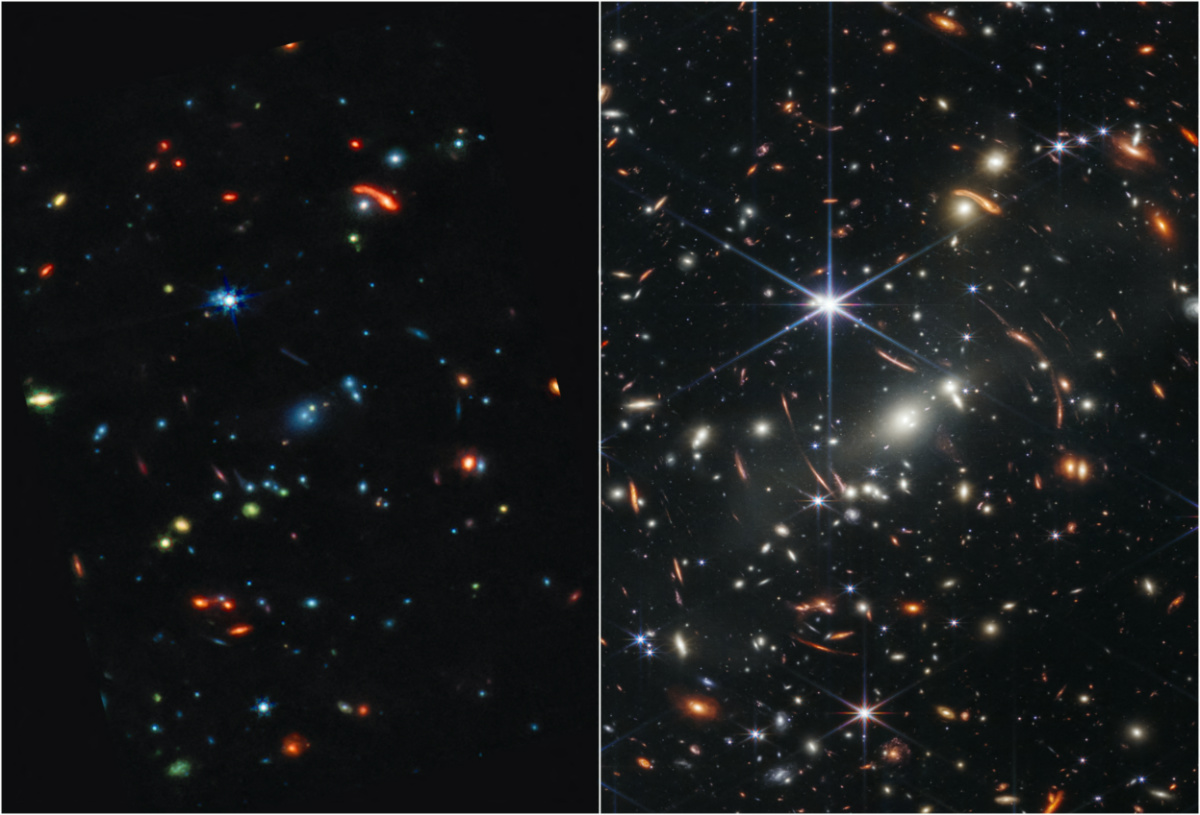
Two full-colour images from NASA’s James Webb Space Telescope, a revolutionary apparatus designed to peer through the cosmos to the dawn of the universe, show composites made from images at Mid-Infrared (L) & Near-Infrared (R) and released on 12th July. PICTURE: NASA, ESA, CSA, STScI, Webb ERO Production Team/Handout via Reuters.
The crowning debut image, previewed on Monday by US President Biden but displayed with greater fanfare on Tuesday, was a “deep field” photo of a distant galaxy cluster, SMACS 0723, revealing the most detailed glimpse of the early universe recorded to date.
At least one faint galaxy measured among the thousands in the image is nearly 95 per cent as old as the Big Bang, the theoretical flashpoint that set the expansion of the known universe in motion some 13.8 billion years ago, NASA said.
We rely on our readers to fund Sight's work - become a financial supporter today!
For more information, head to our Subscriber's page.
Among the four other Webb subjects getting their closeups on Tuesday were two enormous clouds of gas and dust blasted into space by stellar explosions to form incubators for new stars – the Carina Nebula and the Southern Ring Nebula, each thousands of light years away from Earth.
The collection also included fresh images of another galaxy cluster known as Stephan’s Quintet, first discovered in 1877, which encompasses several galaxies NASA described as “locked in a cosmic dance of repeated close encounters.”
Apart from the imagery, NASA presented Webb’s first spectrographic analysis of a Jupiter-sized exoplanet more than 1,100 light years away – revealing the molecular signatures of filtered light passing through its atmosphere, including the presence of water vapor. Scientists have raised the possibility of eventually detecting water on the surface of smaller, rockier Earth-like exoplanets in the future.
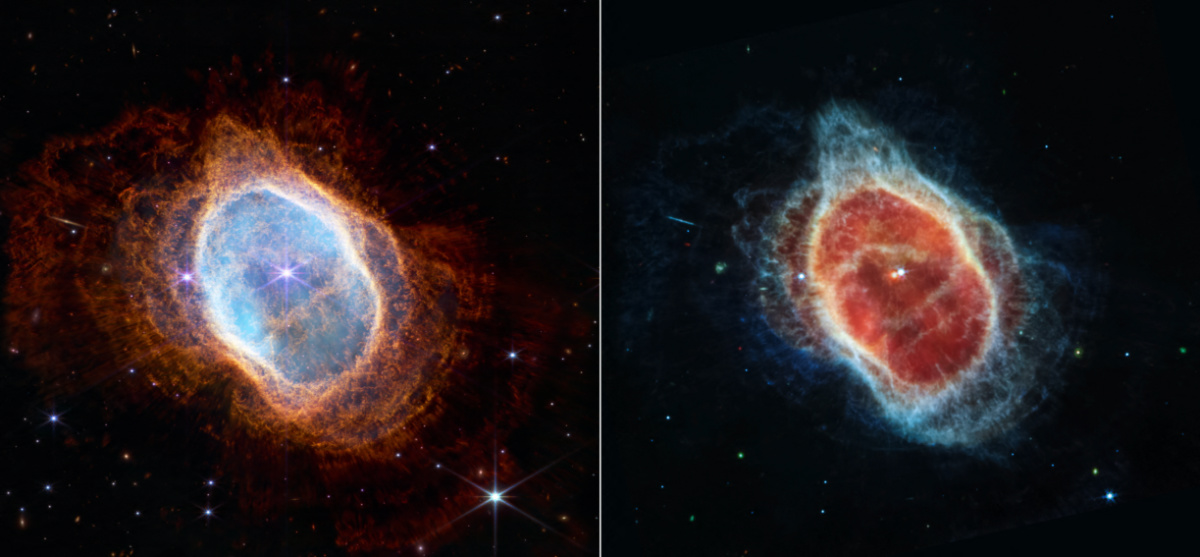
Two side-by-side images show observations of the Southern Ring Nebula in near-infrared light, at left, and mid-infrared light, at right, from NASA’s James Webb Space Telescope, a revolutionary apparatus designed to peer through the cosmos to the dawn of the universe and released on 12th July. In the Near-Infrared Camera (NIRCam) image, the white dwarf appears to the lower left of the bright, central star, partially hidden by a diffraction spike. The same star appears – but brighter, larger, and redder – in the Mid-Infrared Instrument (MIRI) image. This white dwarf star is cloaked in thick layers of dust, which make it appear larger. PICTURE: NASA, ESA, CSA, STScI, Webb ERO Production Team/Handout via Reuters.
“Piece of art”
Built to view its subjects chiefly in the infrared spectrum, Webb is about 100 times more sensitive than its 30-year-old predecessor, the Hubble Space Telescope, which operates mainly at optical and ultraviolet wavelengths.
The much larger light-collecting surface of Webb’s primary mirror – an array of 18 hexagonal segments of gold-coated beryllium metal – enables it to observe objects at greater distances, thus further back in time, than any other telescope. Its infrared optics allow Webb to detect a wider range of celestial objects and see through clouds of dust and gas that obscure light in the visible spectrum.
All five of Webb’s introductory targets were previously known to scientists, but NASA officials said Webb’s early imagery proved it works as designed, better than expected, while literally capturing its subjects in an entirely new light.
The image of Southern Ring Nebula, for instance, clearly showed the dying stellar object at its center was a binary pair of stars closely orbiting one another. The new Carina Nebula photos exposed contours of its massive clouds never seen before.
“This is an art piece that has been revealed by this telescope,” Rene Doyon, principal investigator for the observatory’s Canadian-built near-infrared camera and spectrograph. “It goes beyond my scientific mind.”
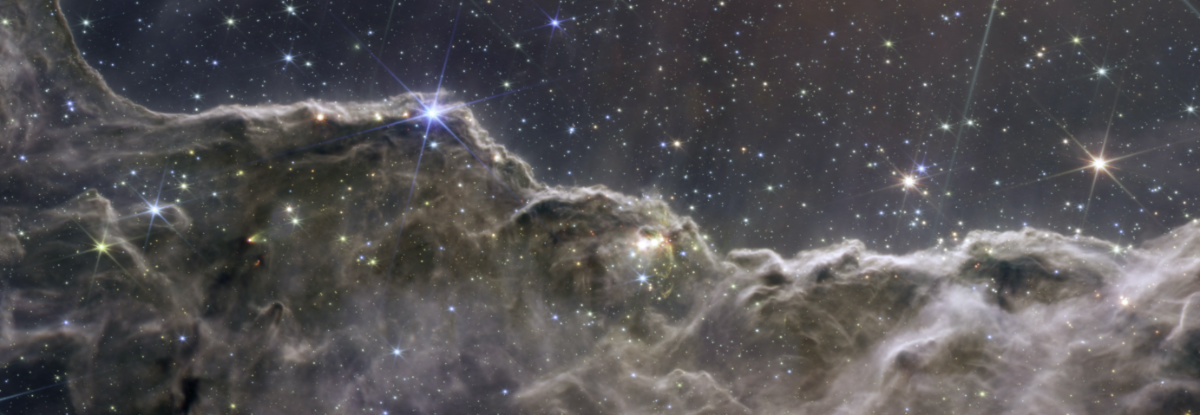
A composite image of the Cosmic Cliffs in the Carina Nebula, created with NIRCam and MIRI instrument data from NASA’s James Webb Space Telescope, a revolutionary apparatus designed to peer through the cosmos to the dawn of the universe and released on 12th July. PICTURE: NASA, ESA, CSA, STScI, Webb ERO Production Team/Handout via Reuters
The SMACS 0723 image showed a 4.6 billion-year-old galaxy cluster whose combined mass acts as a “gravitational lens,” distorting space to greatly magnify light coming from more distant galaxies behind it.
One of the older galaxies appearing in the “background” of the photo – a composite of images of different wavelengths of light – dates back about 13.1 billion years.
The bejeweled-like photo, according to NASA, offers the “most detailed view of the early universe” as well as the “deepest and sharpest infrared image of the distant cosmos” yet taken.
Underscoring the vastness of the universe, the thousands of galaxies appearing in the SMACS 0723 image appear in a tiny patch of sky roughly the size of a sand grain held at arm’s length by someone standing on Earth.
The Webb telescope is an international collaboration led by NASA in partnership with the European and Canadian space agencies.





